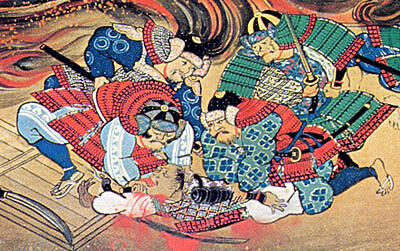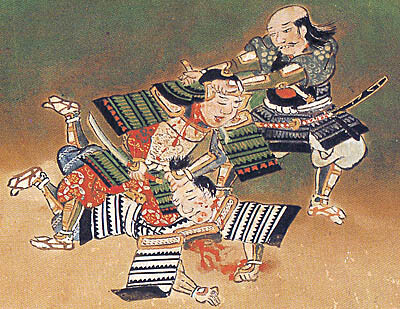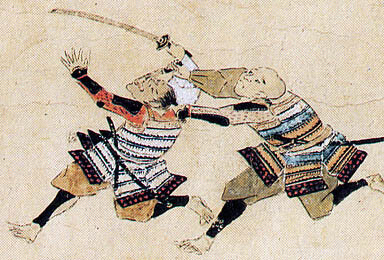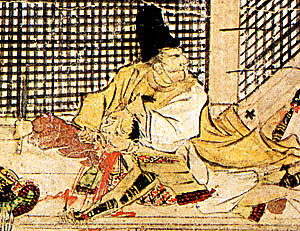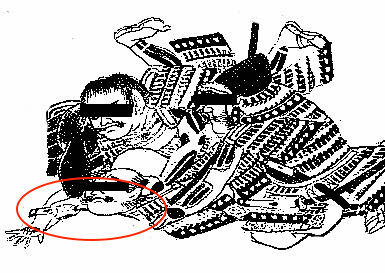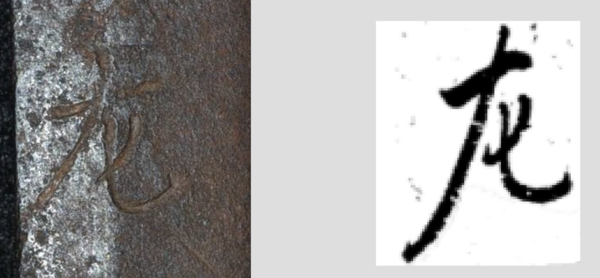-
Posts
925 -
Joined
-
Last visited
-
Days Won
23
Everything posted by Markus
-
Sorry for being slow on this lately. I am about two thirds-through with the book. When reaching the half-way-through-the-book mark, I realized that I slightly have to change the concept. That is, I had to remove oshigata and blade pics and focus more on details in the careers/CV's of the smiths as I was foreseeing the physicals limits of the book. All references will then anyway be available for free online on the website of the project. Apart from that, I still try to edit/add a few smiths every day so that there is no standstill.
-
Will keep my eyes open as well and update if I find one depicted/mentioned in a period painting/source.
-
Jean made me aware of this thread and asked me to join, so I want to add my 2c to the issue: First, I want to address period written sources. Problem here is that earlier ones usually only refer to kubitori (首取り), i.e. the act of taking a head, and not to a specific device. To my knowledge we have to wait to the early period to see devices being address. For example the Musha Monogatari (武者物語) from the mid 1600s and the Zōhyō Monogatari (雑兵物語) from the late 1600s. In the former we find a detailed description of how a certain Mukai Noto no Kami was taking his heads: "First you pin down your enemy to the ground and stop with your right foot on his right arm. Then you fold back the shikoro and cut his windpipe. After that, you hold your wakizashi in reverse grip [...] and cut off the head." The latter source says that it may be difficult to cut off a head with an ō-wakizashi and that rather shorter blades should be used. Now what is interesting to me is the explicit mention of holding the hilt of the wakizashi in reverse grip. Take a look at the pics below. They all show heads being cut off with the handle being held in reverse grip. As the nata-style blade has the cutting edge inside of the curve, obviously none such blade was used in any of the pics shown above. They all cut with the curve outwards (see detail below, don't know why they had to anonymize the guys with bars ). Another problem I am thinking of is that I can't remember seeing any painting of a warrior in armor wearing some extremely curved dagger in his sash like the mounted one provided by Bob in post #36. But that might mean nothing as I probably just don't have come across one yet. Just anecdotal evidence. Now thinking of nata being of exactly that shape, I can't help thinking of samurai sword-style mounted short blades with the cutting edge on the inward curve being just that, i.e. fancy gardening knives maybe worn by a merchant or tea guy who wanted to have something special or by a bushi who was into gardening... So that are basically my thoughts on this issue: No such old blades extant, no explicit mention in period texts, period battlefield depictions ambiguous at the best, fancy mounted ones all date to the (later) Edo period.
-
From my book: "But what about the standards for the ranking of the smiths? [...] There had already been the term ō-kiremono (大切れ物, lit. “great cutter”) to honour a sword which had cut with ease through the central chest of an adult man. The emphasis here lies on with ease because the majority of sword blades should be able after a while to cut through a human chest. The cut going centrally through the thorax, the so-called chiwari (乳割, lit. “breast splitter”), was one of the toughest tests as it had to go through several ribs. Now, when eight or nine blades out of ten from a certain smith turned out to be ō-kiremono, the smith was ranked saijō-ō-wazamono, for seven to eight ō-wazamono, for five to seven ryō-wazamono, and for two to four out of ten wazamono."
-

Samurai Art Expo Utrecht
Markus replied to paulb's topic in Sword Shows, Events, Community News and Legislation Issues
Oops, didn't know that I'm behind with drinks. More than happy to catch up -

Samurai Art Expo Utrecht
Markus replied to paulb's topic in Sword Shows, Events, Community News and Legislation Issues
Argh, would love to go but flights are insanely expensive from here, like $1,800-for-a-roundtrip-for-that-time insanely expensive Have to see if I am somehow able to secure funds... -
Thank you guys. I will ship out to all those who have prepaid automatically. Will probably tackle that tomorrow or at the latest by Friday. I now always wait until the PDF has gone completely through the Lulu system of printers. A while ago, when I published by Masamune book, I placed several orders immediately but then Lulu cancelled them, telling me that something was wrong with the PDF (even after it smoothly went through the first scan but later internal scan said no). Some might remember. Was a little nightmare. IMPORTANT: To all who have prepaid, please let me know if your address has changed since last year. Thank you.
-

Give Back To Caesar What Belongs To Caesar
Markus replied to Jean's topic in Auctions and Online Sales or Sellers
Adding to Brian's comment: ... and if you are seriously considering buying something for $15k, can't be wrong to have someone translate the native Japanese description for let's say 50 bucks, *cough, cough* -
Unworthy? No comment was made about the blade itself, which doesn't look bad at all.
-
Thought it is a two character signature... Having now the whole context, I tend to think it is only one character and somebody clumsily put a Sa (Samonji) gimei onto a mumei blade. Edit: Its the same character though, 左, which is read SA by itself and SUKE in combination with another one (focusing on the readings of swordsmith's names).
-
-
Suke (左). http://clioapi.hi.u-tokyo.ac.jp/ships/ZClient/W34/z_list.php?title=%E5%B7%A6&resourcetype=0
-

Auction Sword - Worth A Look
Markus replied to Vermithrax16's topic in Auctions and Online Sales or Sellers
General info: These "updates" are a reason why I am not going to turn my Kantei series into any monetary venture (as many suggested I better do). In other words, the Kantei series reflects my most recent research and will always be free because it is so to speak backed by the support I have received from readers like Guido who actually buy my books. -

Auction Sword - Worth A Look
Markus replied to Vermithrax16's topic in Auctions and Online Sales or Sellers
Guido, it is insofar different as I realized that a mere master-student-relationship-based genealogy can be kind of skewed sometimes so I tried to focus more on family ties. When going along with my Kantei series, I tried to go once more through all the references and update accordingly, so this might be a reason for differences as well. What I had not incorporated before in my genealogies book but do so with the series is Tsuneishi's Nihontō no Kantei to Kanshō. Actually quite an excellent book which I didn't realize reading it the first time many years ago but it has very good info. -

Auction Sword - Worth A Look
Markus replied to Vermithrax16's topic in Auctions and Online Sales or Sellers
Hi Bob, Check out my Rai genealogy here: https://markussesko.files.wordpress.com/2016/01/genealogyrai.pdf Lilke Guido said, Tsuruta's staff got confused. Kuniyasu did not branch off from Nakajima Rai but a level above so to speak, after Kunisue. -
I was going through my references again but could not find any Nobukuni mei executed like that. What era roughy does the shape and workmanship suggest Ray?
-
@Curran: Someone should have taught me calculating... Kosa was born in 1573 not in 1578. Well, he would still have been only 18 years old when Rikyu died. Makes the issue a little "better" but still pretty young...
-
There is indeed the term sunnobi-sugata but it is not very clearly defined. That is, the term sunnobi-sugata refers to a blade shape that reminds in its overall proportions to a sunnobi-tantō, regardless of its actual nagasa. I might have to point out that subtlety in one of my next Kantei Series chapters. Thanks for bringing it up Jean.
-

Any Info On A Mei Inscribed Bishu Ju Mitsusada
Markus replied to a topic in General Nihonto Related Discussion
I think it is the smith that I have listed as follows: MITSUSADA (光定), Keiō (慶応, 1865-1868), Owari – “Owari no Kuni-jū Mishina Ichidōsai Fujiwara Mitsusada” (尾張国住三品一道斎藤原光定) There was a Mishina group active at that time in neighboring Ise province. Quite possible that he was related to them because they too used go with the ...sai (...斎) ending. -
As Uwe mentioned, the item in the Samurai Art Museum Berlin is not intended to be used. It is a ceremonial axe with sword tip which is referred to as ken'iri-masakari (剣入鉞). This interpretation is a little bit different from a fusô (斧槍) which is a yari with a long tang that has an axe element around it. In other words, the ken'iri-masakari is basically an axe with a normal sword-style nakago ken added on top. Such ritual axes have a quite obvious symbolic meaning, namely "cutting through the sins". As also Buddhist ritual swords have basically that meaning, you have here a good "combo," i.e. cutting off and cutting through the sins." FYI: The axe part is indeed made of steel but it is not sharpened. It has engravings of a dragon in clouds and the sword has a Fudô-Myôô on waterfall horimono. The piece is super heavy BTW
- 11 replies
-
- 11
-

-
Great read! The full English version of the website should be online in a few days by the way.
-
Wow, this is a beautiful koshirae and package!
-
You are right Guido. It is indeed a variant of the 隠 character and can be found in this database: http://jigen.net/kanji/167686 Doing a quick check on Japanese pages for a reading of 小隠 , most seem to quote the name "Shô'in".
-
Interesting history: The sword was tested by Shôdôken Togasaki (尚道軒戸賀崎), i.e. by Togasaki Kumatarô Yoshitake (戸賀崎熊太郎芳武, 1839-1907), who was a swordsman from the Shindô Munen Ryû. His great-grandfather Togasaki KumatarôTeruyoshi had studied with the school founder Fukui and is briefly mentioned at the very top of the Wikipedia page of the ryû: https://en.wikipedia.org/wiki/Shind%C5%8D_Munen-ry%C5%AB
-
Excellent! Subscribed.


